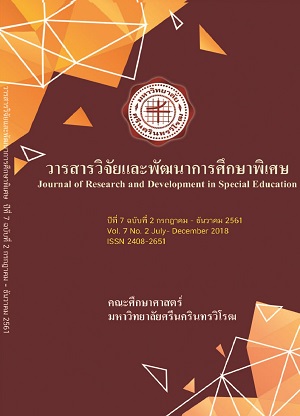ความสามารถด้านการเข้าใจภาษาของเด็กที่มีความบกพร่องทางการได้ยิน ระดับปฐมวัยโดยใช้บทเรียนมัลติมีเดียแบบสตอรี่ไลน์ผ่านอุปกรณ์ระบบหน้าจอสัมผัส (Language Understanding Ability of Preschool Children with Hearing Impairment by using Storyline Multimedia Lesson-)
Abstract
บทคัดย่อ การวิจัยครั้งนี้มีจุดมุ่งหมาย 1) เพื่อศึกษาความสามารถด้านการเข้าใจภาษาของเด็กที่มีความบกพร่องทางการได้ยิน ระดับปฐมวัย โดยใช้บทเรียนมัลติมีเดียแบบสตอรี่ไลน์ผ่านอุปกรณ์ระบบหน้าจอสัมผัส 2) เพื่อเปรียบเทียบความสามารถด้านการเข้าใจภาษาของเด็กที่มีความบกพร่องทางการได้ยิน ระดับปฐมวัย ก่อนและหลังเรียนด้วยบทเรียนมัลติมีเดียแบบสตอรี่ไลน์ผ่านอุปกรณ์ระบบหน้าจอสัมผัส และ 3) เพื่อศึกษาประสิทธิภาพของบทเรียนมัลติมีเดียแบบสตอรี่ไลน์ผ่านอุปกรณ์ระบบหน้าจอสัมผัสเพื่อพัฒนาความสามารถด้านการเข้าใจภาษาของเด็กที่มีความบกพร่องทางการได้ยิน ระดับปฐมวัย ประชากรที่ใช้ในการวิจัยเป็นเด็กปฐมวัยที่มีความบกพร่องทางการได้ยินอายุ 4-5 ปี มีระดับการได้ยินมากกว่า 90 เดซิเบล ขึ้นไป ไม่มีความพิการซ้ำซ้อน กำลังศึกษาชั้นอนุบาลปีที่ 1 ภาคเรียนที่ 2 ปีการศึกษา 2560 โรงเรียนเศรษฐเสถียร ในพระราชูปถัมภ์ จำนวน 6 คน โดยใช้วิธีการเลือกแบบเจาะจง (Purposive Sampling) ดำเนินการทดลองเป็นระยะเวลา 6 สัปดาห์ สัปดาห์ละ 5 ครั้งครั้งละ 20 นาที รวมทั้งสิ้น 27 ครั้ง เครื่องมือที่ใช้ในการวิจัย คือ 1) บทเรียนมัลติมีเดียแบบสตอรี่ไลน์ผ่านอุปกรณ์ระบบหน้าจอสัมผัส และ 2) แบบทดสอบวัดความสามารถด้านการเข้าใจภาษา วิเคราะห์ข้อมูลโดยใช้สถิติพื้นฐานได้แก่ ค่าเฉลี่ย ค่าร้อยละและส่วนเบี่ยงเบนมาตรฐานสถิติที่ใช้เปรียบเทียบ คือ สถิตินอนพาราเมตริก Wilcoxon Signed-Rank Test ผลการวิจัยพบว่า 1) ความสามารถด้านการเข้าใจภาษาของเด็กที่มีความบกพร่องทางการได้ยินระดับปฐมวัย จากการสอนโดยใช้บทเรียนมัลติมีเดียแบบสตอรี่ไลน์ผ่านอุปกรณ์ระบบหน้าจอสัมผัสอยู่ในระดับดี 2) ความสามารถด้านการเข้าใจภาษาของเด็กที่มีความบกพร่องทางการได้ยินระดับปฐมวัย หลังเรียนด้วยบทเรียนมัลติมีเดียแบบสตอรี่ไลน์ผ่านอุปกรณ์ระบบหน้าจอสัมผัสแตกต่างจากก่อนเรียนอย่างมีนัยสำคัญทางสถิติที่ระดับ .05 (p-value = .026) และ3) บทเรียนมัลติมีเดียแบบสตอรี่ไลน์ผ่านอุปกรณ์ระบบหน้าจอสัมผัสมีประสิทธิภาพตามเกณฑ์ที่กำหนดไว้ 80/80 มีค่าเท่ากับ 97.62/95.56 ซึ่งสูงกว่าเกณฑ์มาตรฐานที่กำหนดไว้ Abstract The purposes of this study were 1) to study the language understanding abilities of preschool students with hearing impairment by using Storyline Multimedia Lesson on touchscreen devices, 2) to compare the language understanding skills of the participants via pretest and posttest scores after teaching and learning by the use of Storyline Multimedia Lesson as stimuli on touch-screen devices, and 3) to study the capabilities of the tested multimedia lesson and the devices. Research samples, selected during the second school semester by using Purposive Sampling method and based on the researcher’s criteria, were 6 preschool students 4-5 years of age with hearing loss more than 90 dB from first grade preschool of Setsatian School for the Deaf under the Royal Patronage of His Royal Highness Crown Prince MahaVajiralongkorn. The experiment tools included 1) Storyline Multimedia Lesson constituted seven multimedia stories and one set touch-screen devices, and 2) pretest and posttest forms of language ability. In the first place, pretest was conducted in order to keep the data. Then teaching was carried out for the period of 6 weeks with the total of 27 teaching times, 5 times of 20 minute-session per week. Basic statistical analyses were employed such as average, percentage, standard deviation, and nonparametric test like Wilcoxon Signed-Rank Test. Results indicated that 1) teaching with the use of Storyline Multimedia Lesson on touchscreen devices could enhance language understanding ability of the tested children, 2) Posttest and pretest scores of language understanding ability were statistically different in favour of posttest scores at P level of 0.05 (P value = 0.026). And, 3) the efficiency of Storyline Multimedia Lesson on touch-screen devices between pretest and posttest data were 97.62/95.56 whereas the standard scales were 80/80.Downloads
Download data is not yet available.




